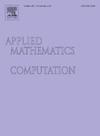超网络中敌对状态的SEIAR谣言传播模型
IF 3.4
2区 数学
Q1 MATHEMATICS, APPLIED
引用次数: 0
摘要
谣言对社会造成严重危害,在传播过程中往往影响公共安全和社会稳定。现有的谣言传播模型研究大多是基于普通图内的二元关系,构建复杂的网络信息传播模型。然而,这些模型很难捕捉到现实社会网络的多维、多属性和多关系的复杂交互特征。基于超图理论,提出了一种能够有效捕捉复杂交互关系的SEIAR(易感-暴露-知情-对抗-去除)谣言传播模型。该模型建立在SEIR框架的基础上,引入了揭穿状态,能够更全面地反映谣言传播和揭穿行为的动态特征。利用平均场理论推导了SEIAR模型的动力学方程,给出了其基本再现数R0的解析表达式,并进行了稳定性分析。研究表明,当R0≤1时,模型的无谣言平衡状态是局部和全局稳定的,最终导致谣言消失。当R0>;1时,谣言持续存在并继续传播。利用龙格-库塔方法进行了数值模拟,验证了理论结果的有效性。随后,利用实际的谣言数据集对模型进行验证,结果表明该模型能够有效地模拟真实社交网络中的谣言传播过程。此外,本文系统分析了拆谣者的影响力、信息控制强度和控制时间、个人兴趣、信息时效性、网络结构等因素对谣言传播的影响,并通过仿真比较了不同模型的传播特征。本文提出的模型拓宽了信息传播研究的视角,详细描述了谣言传播的机制,其中包括一个揭穿状态,为谣言控制策略的制定提供了重要的理论支持。本文章由计算机程序翻译,如有差异,请以英文原文为准。
SEIAR rumor spreading model with antagonistic states in hypernetworks
Rumors pose serious harm to society, often affecting public safety and social stability as they spread. Most existing studies on rumor propagation models are based on binary relationships within ordinary graphs, constructing complex network information propagation models. However, these models struggle to capture the multi-dimensional, multi-attribute, and multi-relational complex interaction characteristics of real-world social networks. This paper proposes an SEIAR (Susceptible-Exposed-Informed-Antagonistic-Removed) rumor propagation model, built upon hypergraph theory, which effectively captures complex interaction relationships. The model builds on the SEIR framework by introducing a debunking state, enabling a more comprehensive reflection of the dynamic characteristics of rumor propagation and debunking behavior. Using mean-field theory, the dynamic equations of the SEIAR model are derived, along with an analytical expression for its basic reproduction number , and a stability analysis is conducted. The study shows that when , the rumor-free equilibrium state of the model is locally and globally stable, ultimately leading to the disappearance of the rumor. When , the rumor persists and continues to spread. Numerical simulations using the Runge-Kutta method were performed to validate the effectiveness of the theoretical findings. Subsequently, the model was validated using actual rumor datasets, and the results showed that the model can effectively simulate the rumor propagation process in real social networks. In addition, this paper systematically analyzes the impact of factors such as the influence of debunkers, information control strength and control time, individual interests, information timeliness, and network structure on rumor propagation, and compares the propagation characteristics of different models through simulation. The model presented in this paper broadens the perspective of information propagation research, providing a detailed depiction of the rumor propagation mechanism that includes a debunking state, and offers significant theoretical support for developing rumor control strategies.
求助全文
通过发布文献求助,成功后即可免费获取论文全文。
去求助
来源期刊
CiteScore
7.90
自引率
10.00%
发文量
755
审稿时长
36 days
期刊介绍:
Applied Mathematics and Computation addresses work at the interface between applied mathematics, numerical computation, and applications of systems – oriented ideas to the physical, biological, social, and behavioral sciences, and emphasizes papers of a computational nature focusing on new algorithms, their analysis and numerical results.
In addition to presenting research papers, Applied Mathematics and Computation publishes review articles and single–topics issues.

 求助内容:
求助内容: 应助结果提醒方式:
应助结果提醒方式:


